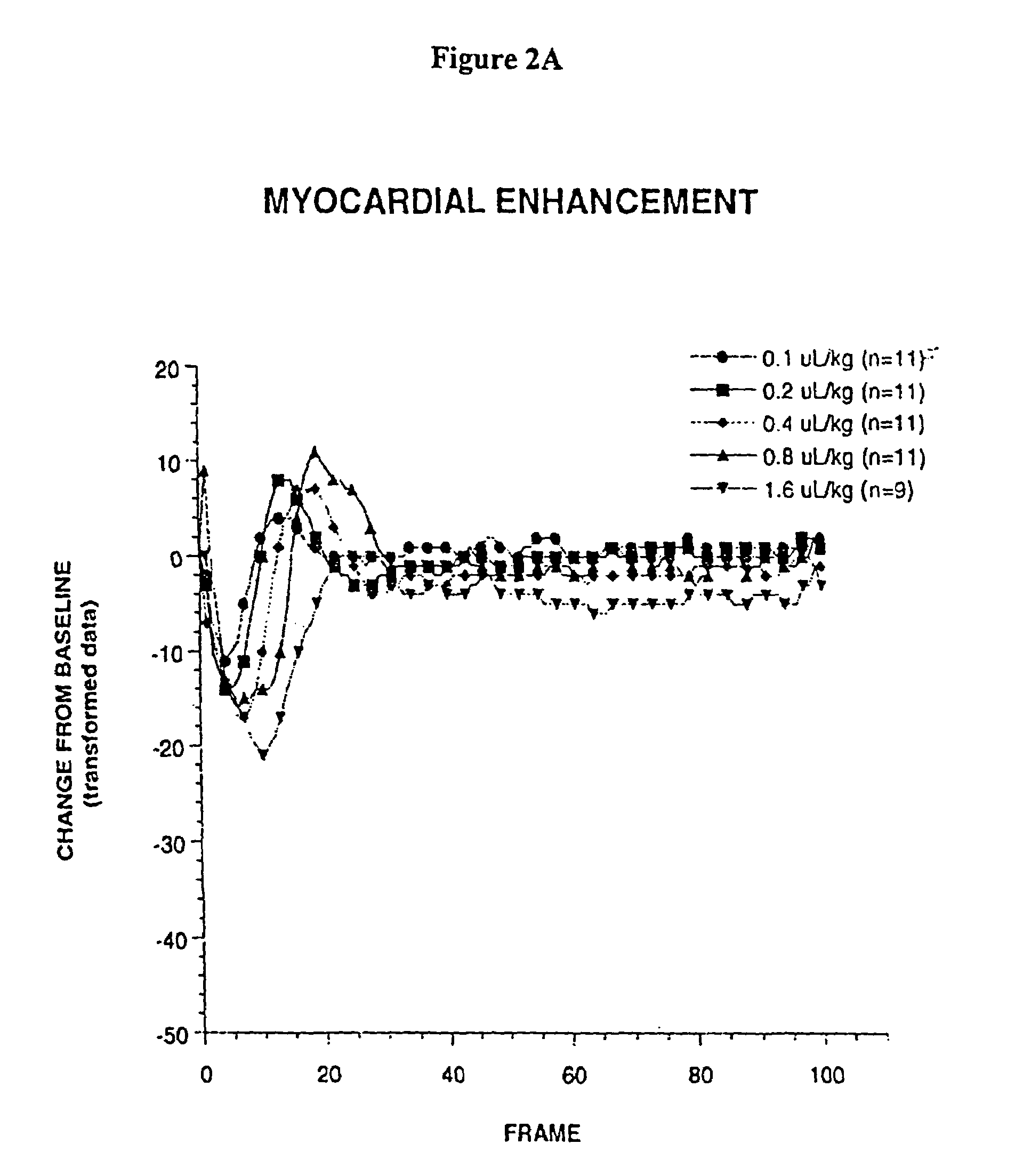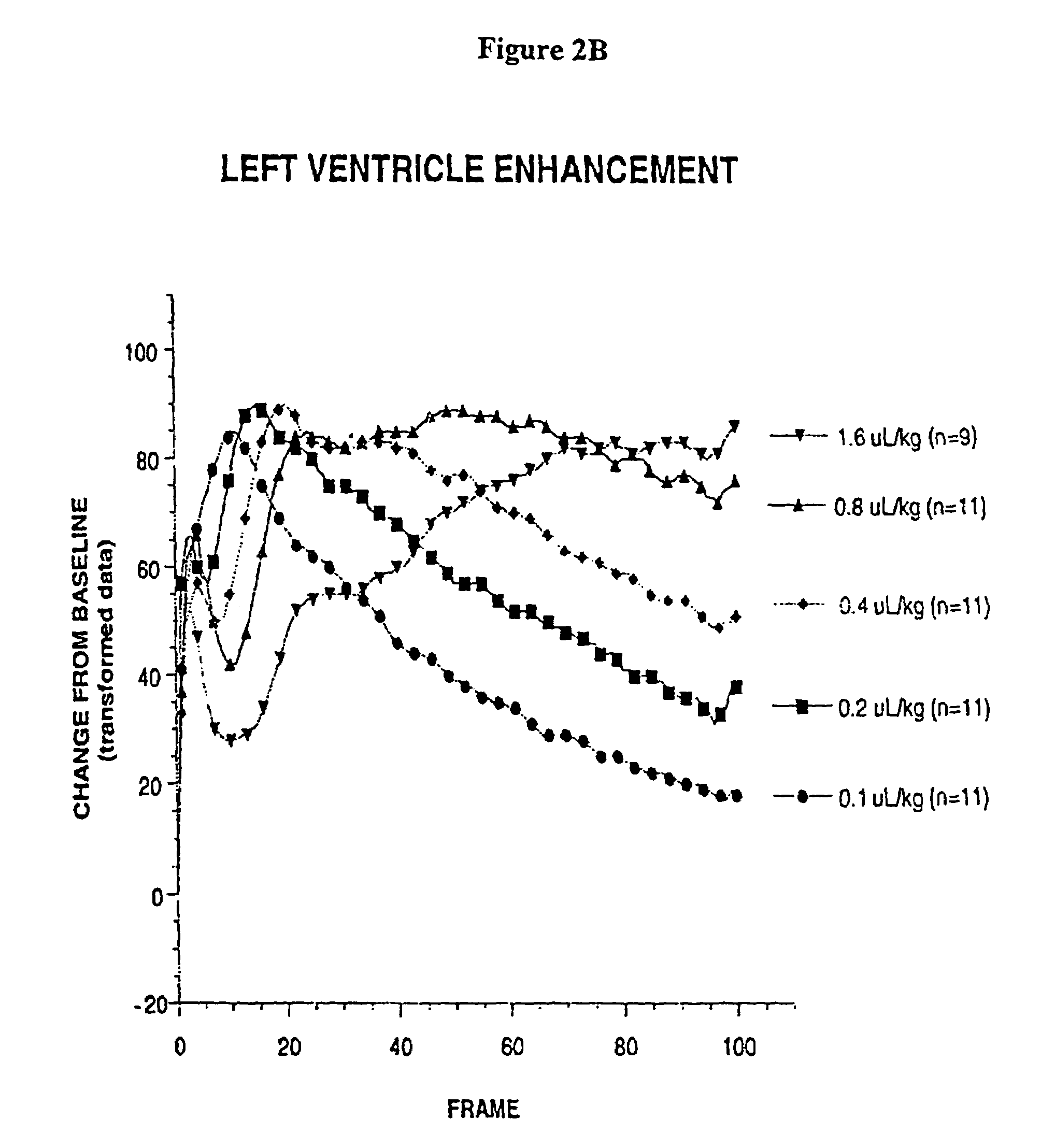Ultrasound contrast agents
a contrast agent and ultrasonic technology, applied in ultrasonic/sonic/infrasonic diagnostics, echographic/ultrasound-imaging preparations, applications, etc., can solve the problems of preventing the left side of the heart from being useful for many purposes, and affecting the use of the left side of the heart. , to achieve the effect of low attenuation, large acoustic changes, and high reflectivity
- Summary
- Abstract
- Description
- Claims
- Application Information
AI Technical Summary
Benefits of technology
Problems solved by technology
Method used
Image
Examples
experimental examples
Example 1
Synthesis of Methoxypolyoxyethylene(˜5,000)docosamide-{DocosamidePEG(5,000), (C21CONPEG[120])}
[0090]Docosanoic acid (0.203 g, 5.96×10−4 mol, Aldrich®) was weighed into a round bottomed flask and dissolved into anhydrous chloroform (5 mL, Aldrich®) and hexanes (1 mL, Aldrich®). To the solution was added excess dicyclohexylcarbodiimide (0.15 g, 7.0×10−4 mol, DCC, Aldrich®). After the solution was stirred a few minutes, an equivalent of N-hydroxysuccinimide (0.081 g, 7.0×10−4 mol, Aldrich®, 97%) was added. The docosanoyl-N-succinimide ester was filtered through a small plug of glass wool contained in a pipette to remove the byproduct urea after stirring for a two hours. The N-succinimide ester was introduced directly into a concentrate of methoxypolyethylene(˜5,000) amine (3.01 g, 6.0×10−4 mol, Sigma®) in toluene left over from the distillation to remove any water. The reaction medium was stirred overnight under nitrogen (Air Products, High Purity Grade). The solution was refl...
example 2
Synthesis of N,N-Bis[2-(docosanoyl)oxyethyl]aminoacetic acid
[0091]Bicine (0.95 g, 5.82×10−3 mol, Aldrich®, 99+%) was added to chloroform (30 mL, anhydrous, Aldrich®, 99+%). A concentrate of docosanoyl chloride, prepared by the reaction of docosanoic acid (4.12 g, 1.14×10−2 mol, Aldrich®) with excess oxalyl chloride (Sigma) in chloroform, was added dropwise to the suspension. After stirring for a few minutes, excess pyridine (1.5 mL, anhydrous, Aldrich®, 99+%) was added to the flask. The flask was refluxed overnight. The reaction mixture was acidified with dilute HCl saturated with sodium chloride (Mallinckrodt, AR®). The aqueous phase was separated. Any remaining volatiles were removed from the organic phase under reduced pressure with mild heating. The glassy product was recrystallized from ethanol (Mallinckrodt, AR®). The product was recovered by filtration as an amorphous white solid. The product weighed 2.86 g after vacuum drying for a 61% yield; mp 73-75° C.; Rf=0.23 (silica ge...
example 3
Synthesis of 1-N′,N′-Bis[2-(docosanoyl)oxyethyl]aminoacetamide-3-N-[methoxypolyethylene glycol(˜5,000)], (C22BicinePEG[120])
[0092]N,N-Bis[2-(docosanoyl)oxyethyl]aminoacetic acid (0.221 g, 2.73×10−4 mol) was weighed into a round bottomed flask and dissolved into chloroform (7 mL, anhydrous, Aldrich®, 99+%). To the solution was added dicyclohexylcarbodiimide (DCC, 0.0625 g, 3.03×10−4 mol, Aldrich®). After stirring for about ten minutes, N-hydroxysuccinimide (0.0345 g, 3.03×10−4 mol, Aldrich®, 97%) was added. Stirring was continued for two hours. The N-hydroxysuccinimide ester was filtered through a small plug of glass wool contained in a pipette to remove the byproduct urea and introduced directly into a concentrate of methoxypolyethylene(˜5,000) amine (1.52 g, 3.03×10−4 mol, Sigma®) in toluene left over from the distillation to remove any water. The solution was stirred overnight under nitrogen. The solution was heated to reflux under a flow of nitrogen for one hour. The product was ...
PUM
 Login to View More
Login to View More Abstract
Description
Claims
Application Information
 Login to View More
Login to View More - R&D
- Intellectual Property
- Life Sciences
- Materials
- Tech Scout
- Unparalleled Data Quality
- Higher Quality Content
- 60% Fewer Hallucinations
Browse by: Latest US Patents, China's latest patents, Technical Efficacy Thesaurus, Application Domain, Technology Topic, Popular Technical Reports.
© 2025 PatSnap. All rights reserved.Legal|Privacy policy|Modern Slavery Act Transparency Statement|Sitemap|About US| Contact US: help@patsnap.com



